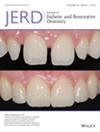The Impact of Modeling Liquids on Surface Roughness and Color Properties of Bulkfill Resin Composites After Simulated Tooth Brushing: An in Vitro Study. Part I
IF 3.2
3区 医学
Q1 DENTISTRY, ORAL SURGERY & MEDICINE
引用次数: 0
Abstract
ObjectiveTo evaluate the effect of different modeling agents on color changes, surface roughness, and translucency parameters over time in Bulkfill resin composites.Material and MethodsSixty specimens were prepared using three Bulkfill resin composites (Tetric N‐Ceram Bulkfill, Filtek One Bulkfill and Opus Bulkfill) and three modeling agents (Wetting Resin, Optibond FL and Ambar APS). All specimens were subjected to a simulated tooth‐brushing (Baseline, 50.000 cycles, 100.000 cycles), and surface roughness was measured at each interval. Surface topography was evaluated. The translucency parameter and color changes were assessed after 24‐h, 7‐, 14‐ and 30‐day immersion in water, wine, and coffee. Data was analyzed using ANOVA and Bonferroni test.ResultsAll specimens increased roughness after simulated tooth‐brushing (模拟刷牙后模型液对填充树脂复合材料表面粗糙度和颜色特性的影响:体外研究。第一部分
材料和方法使用三种 Bulkfill 树脂复合材料(Tetric N-Ceram Bulkfill、Filtek One Bulkfill 和 Opus Bulkfill)和三种造型剂(润湿树脂、Optibond FL 和 Ambar APS)制备了 60 个试样。对所有试样进行模拟刷牙(基线、50,000 次循环、100,000 次循环),并在每个间隔时间测量表面粗糙度。对表面形貌进行了评估。在水、酒和咖啡中浸泡 24、7、14 和 30 天后,对半透明参数和颜色变化进行了评估。结果所有试样在模拟刷牙后粗糙度都有所增加(p <0.05)。润湿树脂降低了 Tetric N-Ceram Bulkfill 的粗糙度(p < 0.05)。所有组别的半透明度参数均保持不变。在葡萄酒和咖啡中浸泡 30 天后,所有组别都会变色(p < 0.05)。本研究结果表明,表面粗糙度和颜色特性会受到造型剂和 Bulkfill 树脂复合材料成分差异的影响。
本文章由计算机程序翻译,如有差异,请以英文原文为准。
求助全文
约1分钟内获得全文
求助全文
来源期刊
CiteScore
6.30
自引率
6.20%
发文量
124
审稿时长
>12 weeks
期刊介绍:
The Journal of Esthetic and Restorative Dentistry (JERD) is the longest standing peer-reviewed journal devoted solely to advancing the knowledge and practice of esthetic dentistry. Its goal is to provide the very latest evidence-based information in the realm of contemporary interdisciplinary esthetic dentistry through high quality clinical papers, sound research reports and educational features.
The range of topics covered in the journal includes:
- Interdisciplinary esthetic concepts
- Implants
- Conservative adhesive restorations
- Tooth Whitening
- Prosthodontic materials and techniques
- Dental materials
- Orthodontic, periodontal and endodontic esthetics
- Esthetics related research
- Innovations in esthetics

 求助内容:
求助内容: 应助结果提醒方式:
应助结果提醒方式:


